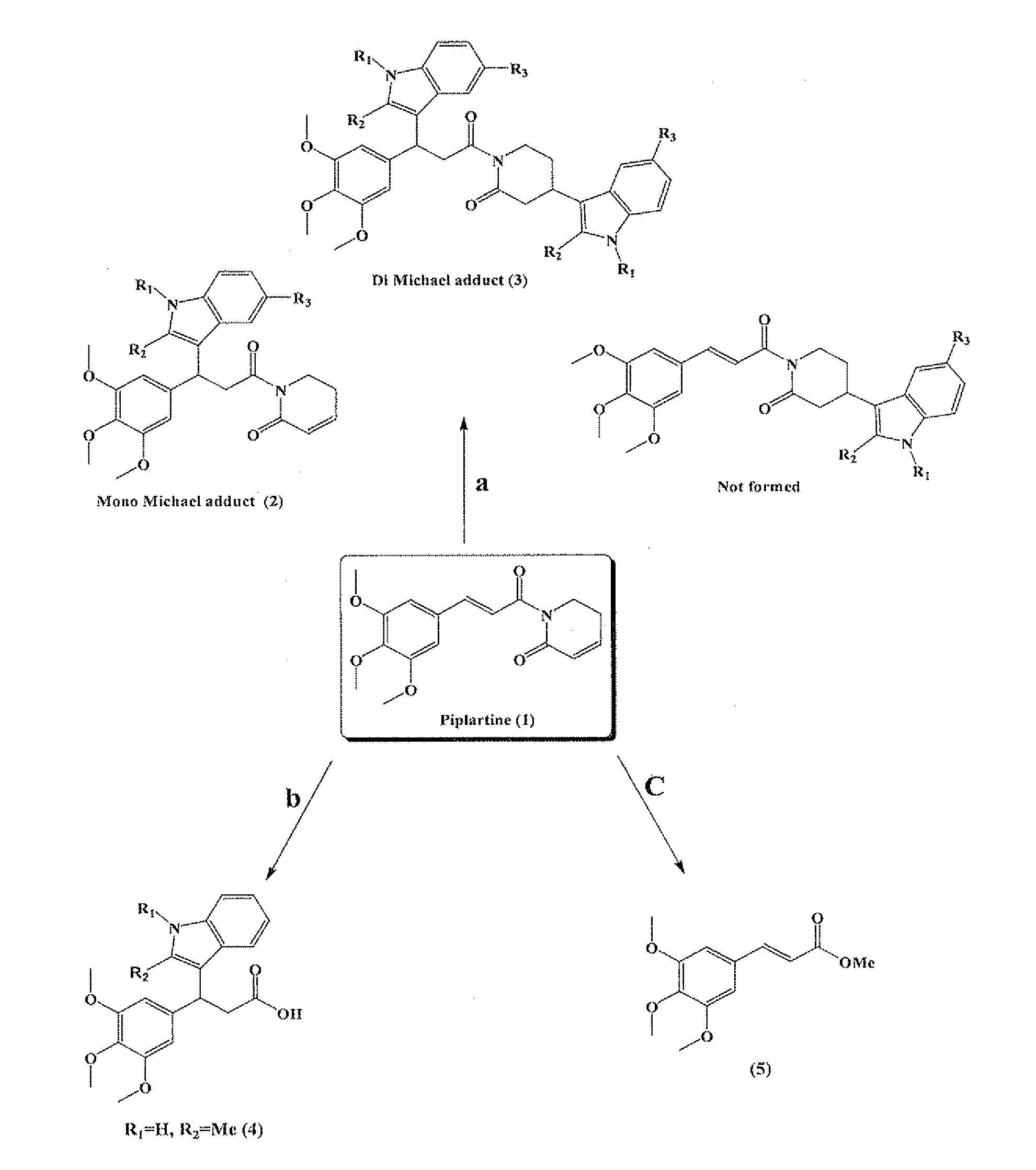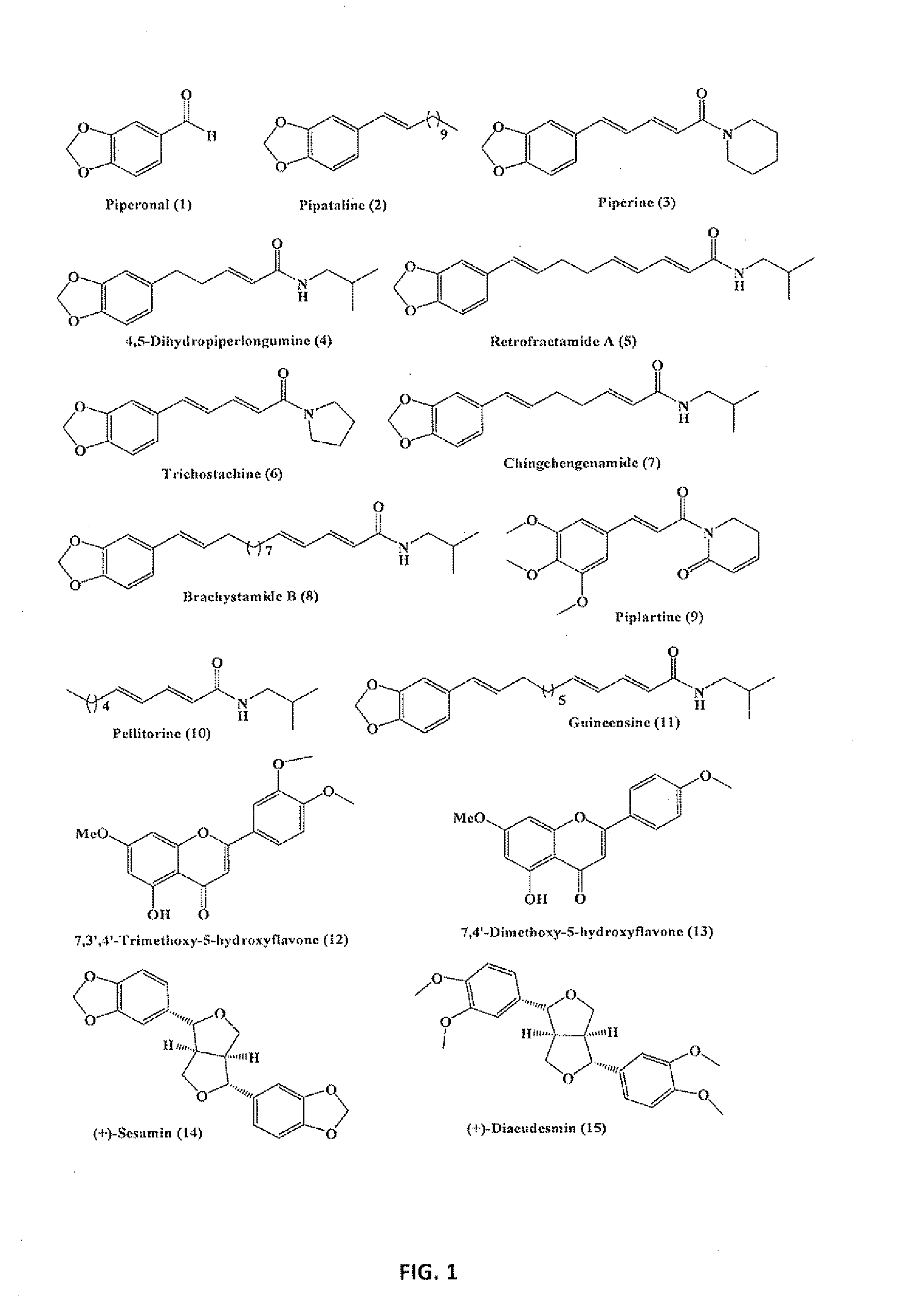Alr2 inhibitors and their synthesis from a natural source
a natural source and alr2 technology, applied in the field of identification of new natural agents, can solve the problems of poor tissue permeability, skin reaction and liver toxicity, morbidity and mortality in diabetic patients, etc., and achieve the effect of suppressing the formation of sorbitol
- Summary
- Abstract
- Description
- Claims
- Application Information
AI Technical Summary
Benefits of technology
Problems solved by technology
Method used
Image
Examples
example 1
[0083]Isolation of Piplartine (1)
[0084]After collection, the roots were cut into pieces, shade-dried and finally ground to coarse powder. The powdered plant material (1 kg) was extracted with hexane (3 L) in a Soxhlet apparatus for 72 h. The solvent mixture was rota evaporated under reduced pressure to yield a yellowish solid (12 g), which gave the first crop of piplartine (2 g) after crystallization from hexane and dichloromethane (8:2).
[0085]Experimental Procedure for (2a & 3a)
[0086]To a mixture of piplartine (0.317 g, 1 mmol) and Indole (0.351 g, 3 mmol), Iodine (0.0127 g, 10 mol %) was added. The contents were refluxed in 1,2-dichloroethane (5 ml) for an appropriate time (48 h). The reaction was monitored by thin-layer chromatography (TLC). After complete conversion, the solvent was evaporated, and the product was washed with saturated hypo solution (10 ml), and then extracted with chloroform. The combined organic layer was dried over anhydrous sodium sulphate and evaporated usi...
example 2
[0111]Spectralchemical and Physical Properties of Piplartine, Hydrolysis Products (4, 5), Michael Adducts (2a-2k) and (3a-3k)
[0112]5,6-dihydro-1-((E)-3-(3,4,5-trimethoxyphenyl)acryloyl)pyridin-2(1H)-one or Piplartine (1) as white needles; mp. 124° C., IR (KBr) νmax: 1660, 1670 cm−1. 1H NMR (300 MHz, CDCl3): δ ppm 2.44-2.52 (2H, m), 3.85 (3H, s), 3.89 (6H, s), 4.04 (2H, t, J=6.61 Hz), 6.03 (1H, td, J=9.6, 1.7 Hz), 6.78 (2H, s), 6.92 (1H, m), 7.41 (1H, d, J=15.48 Hz), 7.64 (1H, d, J=15.48 Hz). 13C NMR (75 MHz, CDCl3): δ 24.3, 41.5, 56.2 (2), 61.0, 105.5 (2), 121.0, 125.5, 130.5, 139.5, 139.9, 143.2, 145.5, 153.5, 165.5, 169.5; HRESIMS m / z 318.1349 [M++H], calcd for C17H19NO5 318.1336.
[0113]3-(3,4,5-trimethoxyphenyl)-3-(2-methyl-1H-indol-3-yl)propanoic acid (4) as light indigo semi liquid; IR (KBr) νmax: 746, 1125, 1237, 1393, 1458, 1590, 1681, 2934 and 3394 cm−1. 1H NMR (300 MHz, CDCl3): δ ppm 2.37 (3H, s), 3.16-3.32 (2H, m), 3.75 (3H, s), 3.81 (3H, s) 4.74 (1H, t, J=7.93 Hz), 6.58 (2...
example 3
[0135]Aldose Reductase Inhibition Studies
[0136](I) Expression and Purification of Human Recombinant Aldose Reductase
[0137]Aldose reductase was cloned from human placenta in PMON 5997 plasmids, which were transformed into E.coli JM101 strain. Transformed cells were selected on LB-medium containing 50 μg / ml spectinomycin and were grown overnight at 37° C. in LB broth containing M9 medium supplemented with 1% casamino acids, 5 pg / ml thiamine, and 0.05% trace metals. Culture was induced by isopropyl thiogalactoside (IPTG) at the final concentration of 1 mM and grown for additional 2 hours. Cells were harvested by spinning at 2000 g for 5 min at 4° C. and subjected to osmotic fractionation by suspending them in 20% sucrose, 30 mM Tris pH 7.5, 1 mM EDTA, and then cells were incubated at 23° C. for 15 min. After incubation, cells were recovered by centrifugation for 15 min at 2000 g at 4° C. Supernatant (sucrose wash) was reserved and pellet was resuspended in 1 ml of ice cold deionized wa...
PUM
 Login to View More
Login to View More Abstract
Description
Claims
Application Information
 Login to View More
Login to View More - R&D
- Intellectual Property
- Life Sciences
- Materials
- Tech Scout
- Unparalleled Data Quality
- Higher Quality Content
- 60% Fewer Hallucinations
Browse by: Latest US Patents, China's latest patents, Technical Efficacy Thesaurus, Application Domain, Technology Topic, Popular Technical Reports.
© 2025 PatSnap. All rights reserved.Legal|Privacy policy|Modern Slavery Act Transparency Statement|Sitemap|About US| Contact US: help@patsnap.com



